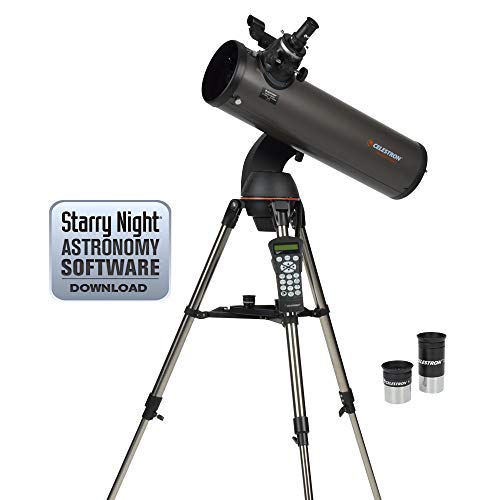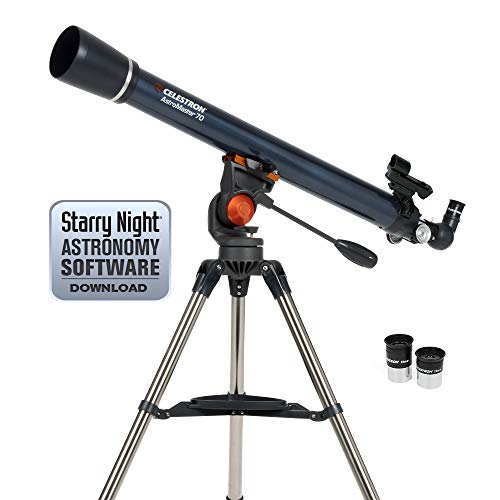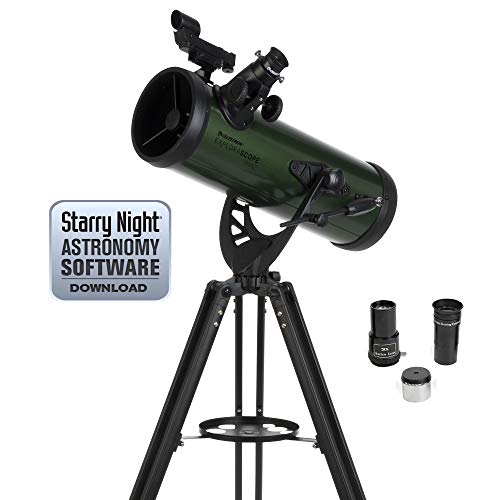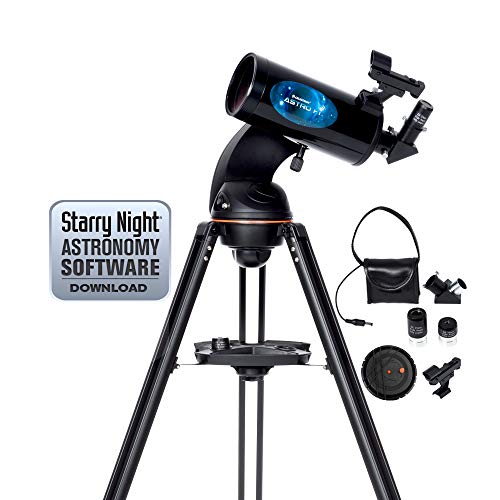9 Best Celestron Telescopes of 2025 – Reviews, Top Picks & Guide
Last Updated on
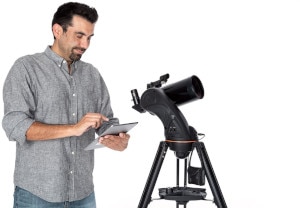
Celestron may be a name you know in the field of astronomy, and the reason is simple. They make good telescopes. If you’re looking to up your astronomy or nature-viewing game, then a Celestron telescope may be an option worth looking into.
While you may think that a company like that would have nothing for beginners, Celestron makes a wide range of telescopes for different budgets and ability levels. That means there’s probably a great option for anyone.
Of course, it can be hard to tell if you’re getting the right telescope when shopping online. Our reviews are designed to cover each scope in detail so you can figure out which one will give you a great experience. Before too long, you’ll be able to gaze up at the stars like never before with a brand-new Celestron telescope.

A Quick Comparison of Our Favorites (Updated in 2025)
| Image | Product | Details | ||
|---|---|---|---|---|
| Best Overall |
 |
Celestron StarBright XLT |
|
CHECK PRICE |
| Best Value |
 |
Celestron NexStar 4 |
|
CHECK PRICE |
| Budget Buy |
 |
Celestron 21035 |
|
CHECK PRICE |
 |
Celestron NexStar 130SLT |
|
CHECK PRICE | |
 |
Celestron 114LCM |
|
CHECK PRICE |
The 9 Best Celestron Telescopes
1. Celestron StarBright XLT Telescope – Best Overall
The Celestron CPC 1100 StarBright XLT 2800mm Telescope is absolutely the best Celestron telescope in the fleet. It has a massive, 11-inch aperture, which is more than enough to make even the dimmest celestial objects visible, even in areas full of serious light pollution. It also includes a 9×50 finderscope, which is as powerful on its own as some full telescopes. There’s a heavy-duty tripod, which greatly reduces vibrations and makes it easy to align this telescope with objects in the nighttime sky.
However, the best thing about this model may be its use of GPS to automatically find and track objects. You’ll be able to see distant objects even if you’re an amateur astronomer, and with its onboard library of more than 40,000 objects, you’ll never run of out new things to see. The one downside is that it’s heavy, weighing 92 pounds between the telescope and the mount. Because of this, it’s not the most portable telescope out there. Still, if you’re looking for a telescope that will allow you to see practically anything in the night sky, you’ll like this model.
All in all, we think that this is the best Celestron telescope on the market right now.
- Very large aperture
- Powerful finderscope
- Heavy-duty tripod
- GPS-connected
- Weight
2. Celestron NexStar 4 Telescope – Best Value
If you’re looking for the best celestron telescope that matches good performance with a price tag that won’t cause heart attacks, the Celestron NexStar 4 SE Telescope may be the right choice. There’s a large, four-inch aperture, which isn’t anywhere near as large as the top selection on our list, but that’s more of a testament to how large that one is. Like our top pick, this model comes with an automated mount, so once you have it aligned, you’ll be able to have this telescope find any of the 40,000+ objects in its library. It’s also easy to set up, so if you don’t want a complicated assembly process, you don’t have to worry with this model.
However, the best thing about this model may be its price. Despite coming with an automated mount, it costs about 16 percent of what our top option costs, making it a great investment overall. The one thing that keeps it out of first place is that it’s not GPS-enabled, so you do have to do some alignment yourself. Still, that’s not a big issue, given how much money you’ll save.
- Large aperture
- Automated mount
- Easy setup
- Great price
- Alignment can be tricky
3. Celestron 21035 Travel Telescope – Budget Buy
The Celestron 21035 70mm Travel Scope is the first one on our list that qualifies as truly portable. It comes with a backpack that’s custom-designed for carrying this telescope and its tripod. Taking this telescope camping, or to a local park, is a quick and easy task. It has a 70-millimeter lens, which isn’t massive, but it’s still respectable. Also included are two eyepieces, with 20x and 40x magnification. This is a far cry from the theoretical maximum magnification of 600x found in our top model, but it’s still enough to make out most of the objects in our solar system.
This one can also be had for a low price. It’s less than a quarter of the price of the second-place one, so this is the telescope to get if you’re looking for the ultimate budget buy. You can’t always get great quality and a great price, but this scope provides both. The only thing we don’t like is that the tripod can be shaky. Still, if you’re looking to save money and get a telescope with great clarity, you’ll like what this model provides.
- Travel-ready
- Large lens
- Two eyepieces
- Fantastic price
- Underwhelming tripod
4. Celestron NexStar 130SLT Telescope
The Celestron NexStar 130SLT Computerized Telescope is another great choice for Celestron fans. It has a computerized mount like the top two models on our list, enabling you to find objects in the night sky, even if you have little astronomy experience. There’s a very large 130-millimeter focal length, which is phenomenal for the price. That’s large enough to let you see just about anything in our solar system, and several deep-space objects as well. It also comes with two high-quality eyepieces. These let you see at 26x and 72x magnification, respectively, so you’ll be able to make the most of your telescope with the included eyepieces.
This scope is arguably the best on our list for photography. While you’ll need to purchase a camera adapter separately, this model has a great reputation in the astronomy community for allowing both experts and beginners to take incredible pictures. The one downside is that it’s a reflector telescope, which means you’ll need to run it through an alignment process called collimation. Other than that, there’s a lot to like about this one for both beginners and experts.
- Computerized operation
- Very large aperture
- Good eyepieces
- Great for photography
- Requires collimation
5. Celestron 114LCM Computerized Telescope
The Celestron 114LCM Computerized Telescope is a good telescope but has some peripheral issues that cost it a few positions on our list. On the plus side, it’s computerized like a lot of the top-performing models. If you haven’t learned how to find stars, nebulas, and other planets in our solar system, this telescope can guide you to them once it’s been aligned. It has a very large 114-millimeter aperture, so you can get great detail that smaller telescopes just can’t match. Plus, it comes with two eyepieces, so you’ll be able to see celestial objects at 60x and 167x magnification right out of the box.
However, this model isn’t power-efficient. In practice, that means it burns through batteries at an alarming rate. If you’re planning to use it a lot, it makes sense to invest in an AC power adapter, though that drives up the price. It also suffers from a shaky mount, so you have to be very careful when making adjustments. This is a decent telescope, but most people will find that they can get better value for the money with a different telescope.
- Computerized
- Very large aperture
- Two eyepieces
- Burns through batteries easily
- Shaky mount
6. Celestron AstroMaster 70AZ Refractor Telescope
The Celestron 21061 AstroMaster 70AZ Refractor Telescope is positioned as an entry-level telescope, but there are some reasons that beginners could be better served by a different scope. This one does come with an alt-azimuth mount, which is better than expected on a telescope at this price point. That makes it easy to align this telescope and keep it aligned with objects in the night sky. It also has a reputation for being very easy to assemble, and it’s not a reflector telescope, so you’ll never have to collimate it. Plus, it comes with 45x and 90x magnification due to its great included eyepieces.
Still, some problems make it less than what one would hope for from the Celestron brand. Like a lot of low-priced telescopes, the mount is shaky and becomes especially problematic when the wind is blowing. Something else to consider is that 70 millimeters is fairly small as far as telescopes go. It could compromise your ability to see objects outside our solar system, and you won’t get great detail looking at other planets. That means many people will be disappointed with their purchase, despite the low price.
- Smooth positioning
- Easy setup
- Two eyepieces
- Shaky tripod
- On the small side
7. Celestron PowerSeeker 127EQ Telescope
The Celestron PowerSeeker 127EQ Telescope has the potential to be one of the best that an amateur ever owns. With an incredibly large 127-millimeter aperture, it’s one of the largest telescopes on our list. If you want to view other planets in our solar system, this one can get the job done. Its design also lends it a phenomenal 1000-millimeter focus length, which is far longer than most consumer telescopes, and means you have a high theoretical maximum magnification. Also included is a Barlow lens, which triples the magnification provided by the telescope and the eyepiece you use. This allows between 150x and 450x magnification, which is very high for a consumer telescope.
However, it has some of the problems that tend to come with low-priced telescopes. It has a shaky tripod, which means you have to be gentle when focusing. Otherwise, the image will be blurry. This is a reflector telescope, so it requires collimation. Unfortunately, it’s not the easiest model to collimate. If you’re patient and willing to invest in a better tripod, you can get good use out of this scope. Otherwise, you’ll probably dislike it.
- Very long focal length
- Very large aperture
- Includes Barlow lens
- Poor-quality tripod
- Difficult collimation
8. Celestron ExploraScope Reflector Telescope
The Celestron ExploraScope 22103 114AZ Reflector Telescope is priced like a beginner’s telescope, but it has some shortcomings that make it a poor choice except for those who really want to learn. On the plus side, it has a stable mount and tripod, so you won’t have to worry as much about that part interfering with your operation. There’s a 114-millimeter aperture, which is fairly large for the price. The included 2x Barlow lens is a nice touch, increasing what you can do with this telescope and its eyepieces without driving the price up too much.
New users should hesitate before buying this telescope, since it requires frequent collimation. It doesn’t stay aligned as well as other models, and this level of maintenance may be more than most casual users want. It also lacks detailed documentation, so it’s not as easy to set up and use as other options on our list. The big problem is that it isn’t large enough for advanced users, but doesn’t have the ease of use of entry-level telescopes. Overall, it’s okay, but most experts and beginners will find that it doesn’t meet their needs.
- Stable mount
- Large aperture
- Includes Barlow lens
- Requires frequent collimation
- Not enough documentation for beginners
9. Celestron Astro Fi 102 Telescopes
The idea of a wi-fi-enabled telescope is good, but the Celestron Astro Fi 102 fails to live up to most users’ expectations. Its big selling feature is that it comes with a wi-fi card, so you can connect it to your home network or to a cellphone, and control it through your smartphone. There’s also a cellphone adapter, which allows you to take pictures and use your cellphone as a screen so multiple people can view the image at once.
However, that means you can’t use your smartphone as a screen and use the app that controls the telescope at the same time. That’s only the first of its major problems. The app Celestron provides is prone to freezing and crashing, which makes using this telescope a pain. It also doesn’t have an AC power supply, and given its wi-fi capabilities, it burns through batteries very quickly. It also has some cheap parts that don’t seem up to the standards found on other Celestron products. Overall, this model represents a cool concept, but it’s likely to leave people frustrated.
- Wi-fi ready
- Smartphone adapter
- Some cheap parts
- No AC power supply
- Poor app performance
Related Read: How does Celestron telescopes compare to Orion ones?

Conclusion
The Celestron CPC 1100 StarBright XLT 2800mm Telescope is one of the best celestron telescopes on the market, due to its massive aperture, heavy-duty tripod, and GPS-connected alignment system. The Celestron NexStar 4 SE Telescope earns second place with its large aperture, automated mount, and easy setup, and its low price earns it the title of “best Celestron telescope for the money.” In third is the Celestron 21035 70mm Travel Scope, which is travel-ready and has a large lens and two eyepieces, plus a bargain price.
The Celestron NexStar 130SLT Computerized Telescope comes with a very large aperture and good eyepieces. It’s great for photography, though its need for collimation hurts its value. Fifth place belongs to the Celestron 114LCM Computerized Telescope, which has a very large aperture and two eyepieces but suffers from poor power efficiency and a shaky mount. Sixth place is taken by the Celestron 21061 AstroMaster 70AZ Refractor Telescope, which provides a smooth position and easy setup but loses value because of its shaky tripod and smaller size.
The Celestron PowerSeeker 127EQ Telescope has a very long focal length and a very large aperture but falls to seventh because of its poor tripod and difficult collimation. In eighth place is the Celestron ExploraScope 22103 114AZ Reflector Telescope. It has some positives, but its problems mean that neither experts nor beginners will get good value out of it. The last place belongs to the Celestron Astro Fi 102, which is wi-fi ready and includes a smartphone adapter. The app’s poor performance and overall low-quality parts mean that few people will enjoy using it.
We hope our reviews of the best Celestron telescopes have helped you better understand this great brand, and have helped you find one that will give you a great experience on a budget that will work for you.
We also compared Celestron telescopes to Meade telescopes in this article. Definitely worth checking out before buying.
We wish you good luck with finding the best Celestron telescope for your needs!
- You might also be interested in: What Colors Are Stars? [Astronomer’s Guide With Color Chart]
Table of Contents
- A Quick Comparison of Our Favorites (Updated in 2025)
- The 9 Best Celestron Telescopes
- 1. Celestron StarBright XLT Telescope – Best Overall
- 2. Celestron NexStar 4 Telescope – Best Value
- 3. Celestron 21035 Travel Telescope – Budget Buy
- 4. Celestron NexStar 130SLT Telescope
- 5. Celestron 114LCM Computerized Telescope
- 6. Celestron AstroMaster 70AZ Refractor Telescope
- 7. Celestron PowerSeeker 127EQ Telescope
- 8. Celestron ExploraScope Reflector Telescope
- 9. Celestron Astro Fi 102 Telescopes
- Conclusion
About the Author Robert Sparks
Robert’s obsession with all things optical started early in life, when his optician father would bring home prototypes for Robert to play with. Nowadays, Robert is dedicated to helping others find the right optics for their needs. His hobbies include astronomy, astrophysics, and model building. Originally from Newark, NJ, he resides in Santa Fe, New Mexico, where the nighttime skies are filled with glittering stars.
Related Articles:
How to Clean a Refractor Telescope: Step-by-Step Guide
How to Clean a Telescope Eyepiece: Step-by-Step Guide
How to Clean a Rifle Scope: 8 Expert Tips
Monocular vs Telescope: Differences Explained (With Pictures)
What Is a Monocular Used For? 8 Common Functions
How to Clean a Telescope Mirror: 8 Expert Tips
Brightfield vs Phase Contrast Microscopy: The Differences Explained
SkyCamHD Drone Review: Pros, Cons, FAQ, & Verdict







